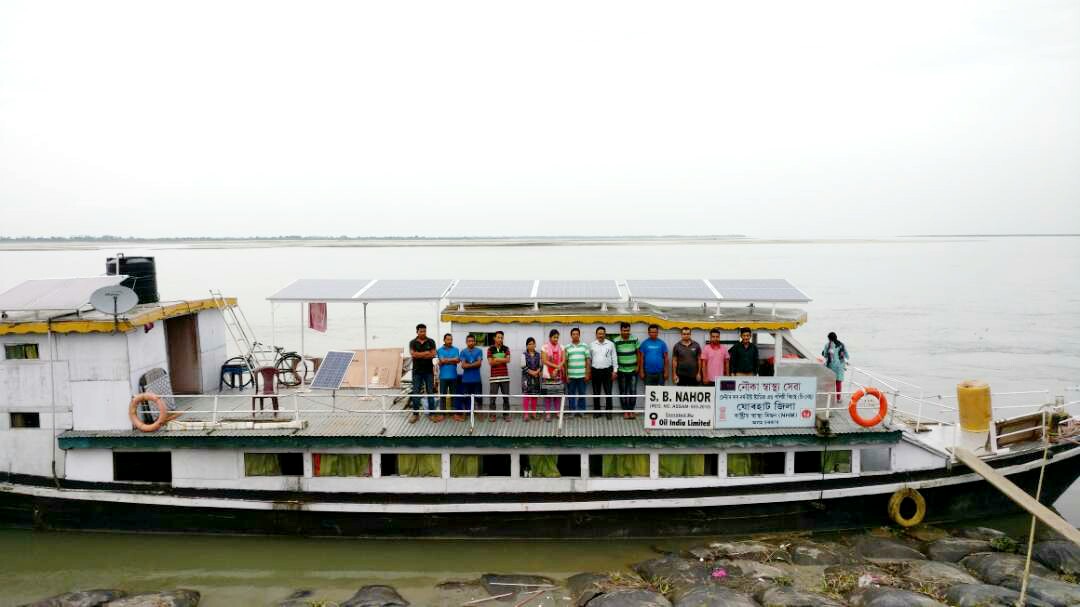How Do Brahmaputra’s River Islands Get Healthcare? Check out These Boat Clinics!
Better reliability, longer operational hours and added services improve healthcare delivery for remote island communities of North-East India.

For communities perilously living in flood prone areas, access to basic resources and opportunities is a perpetual challenge. River islands especially lack basic infrastructure and services such as healthcare, education, power, drinking water, and sanitation. People risk weather conditions and flooded rivers to travel through difficult terrains and get basic health care services such as vaccinations, mother and child care, medicines, minor operations, etc. Medical emergencies can be particularly harrowing. Similar challenges are prevalent across the Sundarbans in Bangladesh, coastal areas of Rakhine in Myanmar, the lakes of Cambodia, and many other areas.
Mobile boat clinics were developed as a response to this need. For example, a vast network of shifting islands characterise the River Brahmaputra in its 891 km course through Assam in North East India. To provide basic health services to these communities, the Centre for North East Studies and Policy Research (C-NES) designed and built boat clinics, which have reached over 1.5 million people since 2005.
Bridging the energy gap
With the length of trips varying from a single day to several days, one of the biggest challenges that these clinics face is access to energy for powering basic health and communication equipment. Typically, the entire load is on a diesel generator, the use of which is limited by the amount of diesel that can be stored on the boat. This results in the services being terminated early every day. Diesel is also difficult to procure on the islands and the intense noise from the generator makes it difficult to work on the boat.
In April 2017, with technical support from SELCO Foundation and Envo Business Solutions Pvt Ltd, the first solar powered boat clinic in the North-East was commissioned in Jorhat district of Assam. All the equipment on the boat that used to run on diesel now runs on solar energy, which means that the boat itself has more diesel available to stay on the river longer. In the evening, the services are open till all patients are treated (especially for emergencies), and the staff have more time to complete their work.
The boat now has a solar powered vaccine refrigerator, making it possible to also start storing vaccines, medicines and lab reagents, which otherwise had to be stored in ice boxes for a limited time.

Challenges and Opportunities
Retrofitting a boat with solar power has certain challenges. Panels and batteries add over 500 kg, which need to be balanced across the span – this is a bigger worry for smaller boats than for larger ones. A waterproof space needs to be designed for batteries, panel mounting structures preferably made from aluminium to prevent rusting and sturdy enough to withstand high wind speeds. To reduce the size of the solar system, every watt makes a difference – low energy, high efficiency portable medical equipment needs to be developed for these reasons.
The idea of boat clinics challenges conventional healthcare delivery models, which rely on a network of stationary primary health centers to which people have to travel from far off places. A boat clinic takes healthcare to the doorstep of the people. Appropriately designed efficient health technologies could further enhance such doorstep services.
These concepts find relevance in many other sectors. Take for example the solar powered floating schools of Bangladesh. Fishermen venturing out into the sea for extended periods of time, vendors in floating markets, rescue boats in rough seas – all face similar challenges around access to energy. There is an immense opportunity for energy enterprises to design solutions for these situations, and more partnerships are needed to institutionalise the learnings from these experiments.
This project was supported by GIZ and Good Energies Foundation. If you would like to partner with us to take this initiative forward, please write to [email protected].
About the author: Vivek Shastry works with the Policy and Planning Group at SELCO Foundation. He focusses on energy planning, ecosystem development, and energy-healthcare nexus.
This article was first published by Power for All.
Like this story? Or have something to share?
Write to us: [email protected]
Connect with us on Facebook and Twitter.
NEW: Click here to get positive news on WhatsApp!
If you found our stories insightful, informative, or even just enjoyable, we invite you to consider making a voluntary payment to support the work we do at The Better India. Your contribution helps us continue producing quality content that educates, inspires, and drives positive change.
Choose one of the payment options below for your contribution-
By paying for the stories you value, you directly contribute to sustaining our efforts focused on making a difference in the world. Together, let’s ensure that impactful stories continue to be told and shared, enriching lives and communities alike.
Thank you for your support. Here are some frequently asked questions you might find helpful to know why you are contributing?


This story made me
-
97
-
121
-
89
-
167











